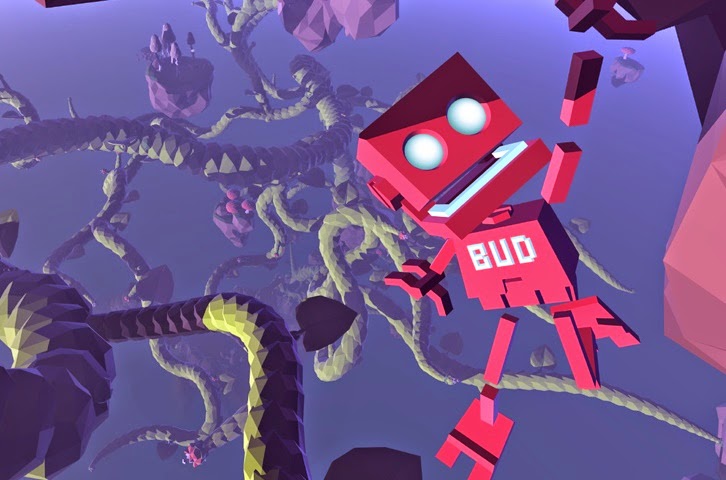When Grow Home was announced, the developers told us that it was drawing inspiration from Wall-E and The Hitchhikers Guide to the Galaxy. Having played it now, I would suggest the official line throw in a third inspiration; Jack and the Beanstalk.
Originally an internal Ubisoft project designed to test some physics models and entertain the staff, Grow Home as a tech demo was so impressive that it evolved into a commercial project. The game puts players in control of a bright red robot called BUD (short for Botanical Utility Droid) who has a simple objective of growing a massive beanstalk-like plant called the Star Plant so he can harvest the seeds.
A major part of the game’s charm comes from the detailed floating islands that form its playground. There is a wide range of flora and fauna which populate the landscape, breathing life into the surroundings. In clambering over the Star Plant the main interaction comes from the mushrooms and leaves that BUD can jump on, as well as the various flower types it can equip to float about the place.
Majestic caves litter the landscape and some of the islands have Energy Rocks inside them which produce a glowing green radiation. By climbing on top of a Star Shoot projectile device and taking aim at these rocks, the Star Plant can absorb the energy, which causes it to pulsate and then grow, giving BUD access to even more areas.
Grow Home has a minimalistic control structure. Playing with a gamepad, BUD’s legs are controlled by the control stick and his arms by the triggers. This control system is very naturalistic, and after a few moments of play it becomes a real joy to explore this way through such a pleasant, open environment. The basic climbing mechanic involves placing one of BUD’s hands after the other, and as much as that connects players with the character by so efficiently emulating what BUD is doing on-screen, it does have some issues in execution. BUD moves like a sloth as he clings to whatever he is climbing on, and the cumbersome nature of controlling BUD ends up being the main reason the game runs even the short time that it does. With the world inviting exploration and encouraging players to experiment with how they move around it, for the mechanics to then discourage those same things is perhaps a layover from the tech demo origin of the game, and I hope that a future game that expands on this mechanic irons out that mechanical issue.
BUD’s animation is based around procedural techniques which allows it to flop around as it walks around or climbs. When BUD jumps on an propulsion leaf or flower his animation and movement is smooth, energetic, and utterly delightful. It’s not perfect, with BUD reacting oddly at times when encountering some objects, however it is nonetheless an animation system that encourages players to forget the main task of the game and simply explore of muck about. At the start of the game you’ll have a smile on your face thanks to BUD’s personality as conveyed through his movements, and that smile will remain there at the end.
Spaced across the map are teleportation pads, which are hugely beneficial in allowing BUD to quickly jump from one location to the other without having to go through the laborious process of climbing everywhere. Some of these are placed in the path of the player, but others are hidden on small planetoids that are off the beaten track and require some exploration to track down. They function as the game’s hidden rewards, in other words, and while they may be a concession to the need to turn a tech demo into a sellable product, we’ve seen less worthwhile collectibles in the past, and at least there’s a reason to go hunting for these.
BUD will also find crystals as he explores around the place, and these can be used to unlock power ups. The most useful of the upgrades unlocked is the jetpack, which can then upgraded a number of times. On the other hand, there are powerups that are truly odd – and at odds with principles of good game design. Being able to control the camera is an unlockable, for example, and later in the game I’d argue you need control over the camera. Again it seems like a concession that Grow Home’s origins needed something in order to turn into a commercial product, and this was the path the developer decided to go.
Once you have explored the map fully and acquired all the crystals there isn’t much of a reason to come back. There’s only one map to play on, and it’s not a huge game to play though. Given the budget price of Grow Home and its sheer entertainment value to play through even once, it’s difficult to criticise the length of the game though. It’s an experimental project by Ubisoft and we hope to see more like it in the future.
You should be left feeling bubbly after playing Grow Home. It’s not perfect in execution, but given it was never meant to be a commercial product, it’s easy to see why Ubisoft couldn’t resist turning it into one – it’s a bright, charming and original little game that has an irresistable sense of happiness to it.
– Trent P.
Contributor










